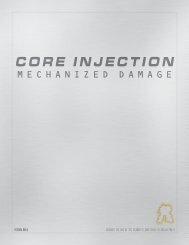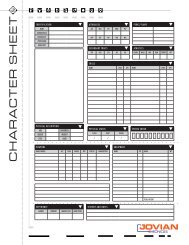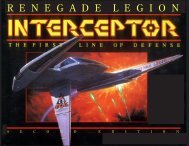renegadelegionneveren dingoffensive - Catsden.net
renegadelegionneveren dingoffensive - Catsden.net
renegadelegionneveren dingoffensive - Catsden.net
You also want an ePaper? Increase the reach of your titles
YUMPU automatically turns print PDFs into web optimized ePapers that Google loves.
RVLS<br />
DA M AG E RV L E S<br />
Vehicle Damage Rules<br />
These rules are for Interceptor and Centurion.<br />
Affecting the way damage is recorded and in some<br />
cases, the way internal components are damaged or<br />
destroyed, these alternate rules essentially follow<br />
the standard Centurion model of damage notation,<br />
save the “shape” of the tank and the “shape” of the<br />
internals. Furthermore, this system has been adapted<br />
to Interceptor as well, unifying the two systems in<br />
terms of damage demarkation. (While the Interceptor<br />
rules are great as they stand, this way is faster, can be<br />
a bit more interesting, and in times of the two games<br />
meeting, the unification helps make more sense)<br />
The change in the vehicle’s record now takes more<br />
into account the actual internal layout of a tank/<br />
interceptor. As well, more related information is now<br />
shown on each sheet. One sheet is now required per<br />
tank, however, rather than one per platoon, so this is<br />
a bit of a drawback. Nevertheless it is worth this extra<br />
photocopying expenditure.<br />
New record sheets are provided at the end of this book.<br />
Permission granted to photocopy for personal use.<br />
Before play, fill out the appropriate record sheet, much<br />
as one did under the standard rulesheets.<br />
Recording Damage is done exactly as it is on the<br />
standard Centurion record sheet. Apply damage to<br />
the appropriate armour facings, using the templates,<br />
rolling for column, and so on. Armour is widowed, and<br />
damage continues internally just as under the Centurion<br />
rules, with no changes.<br />
However, internal components are not destroyed in the<br />
same way. Instead of expiring on the first hit, a die is<br />
rolled versus a target number, based on the accumulated<br />
damage, to see if the component survives or is wasted.<br />
Destroyed pieces of equipment hamper the vehicle just<br />
as described in the Centurion or Interceptor rules; the<br />
only change is the method of determining if and when<br />
they are rendered out of commission. If a component<br />
has two locations, it is the total damage done on both<br />
locations that is used when referencing the item’s Save<br />
Target Number. Note that both locations do not need to<br />
be hit for the item to be rendered inoperative, all that is<br />
required is a failed roll.<br />
There are certain cases when a vehicle does not<br />
have a particular element, yet it is still listed on the<br />
record sheet. (The Infantry Bay is the most common<br />
occurrence, but it can also be one of the Weapon<br />
Locations. Laser Capacitors also count as ammo (they<br />
can explode) so not having any missiles, gauss or MDC<br />
weapons does not exclude one from having an ammo<br />
bay. Unless your vehicle isn’t carrying _any_ weapons,<br />
you have an ammo bay. -grin-) When this situation<br />
arises, the following rule applies to damage incurred<br />
on the record sheet: The location absorbs damage and<br />
acts normally for the first hit it takes, but for the first<br />
hit _only_. Immediately following the first weapon<br />
strike, _all_ boxes for that component are marked off<br />
as destroyed. Essentially, the component no longer<br />
exists there.<br />
Ex: A Trajan tank takes a hit on it’s Stern facing from a<br />
Liberator. The 5/6 laser and the 150mm strike the tank.<br />
The 150 rolls the number 5 column, which already<br />
reaches 2 boxes into the tank, while the laser hits the<br />
number 6 column, which still has 4 points of armour<br />
on it. The laser, having been fired first, manages to<br />
bore a hole into the (truthfully non-existent) infantry<br />
compartment. The one point of damage is assessed,<br />
and then the _entire_ infantry compartment is<br />
scratched out. Next, the 150’s hit is assessed. With<br />
the infantry compartment gone, the APDS shell sails<br />
into the Power Plant, crumpling it. HOWEVER, if the<br />
weapon hits had been reversed, the 150mm would have<br />
done but 3 points of damage to the engine (the infantry<br />
compartment working to its fullest extend during its<br />
first hit), and the 5/6 laser would have done nothing<br />
save taken off more armour and ballistic protection.<br />
(Unless the Alternate Laser Damage rules are being<br />
used from the Technical Update, in which case a whole<br />
point of damage would have been inflicted upon the<br />
Power Plant).<br />
It may sound a bit complicated, but in practice, it isn’t.<br />
The Damage Assesement tables on the following pages<br />
represent the target number required to be rolled to<br />
avoid a section being destroyed. The top row represents<br />
the amount of damage done to the component (in # of<br />
boxes done) while the second row is the target number<br />
itself. Many modules have a second save to prevent the<br />
item from shorting out for one turn. If this roll fails, the<br />
item is unusable the following turn, but is functional<br />
the turn after that (provided it isn’t destroyed or shorted<br />
out again). Too speed up play, it is suggest both saves<br />
(Destroyed and Short) be rolled simultaneously on<br />
different coloured dice.<br />
XXIV





